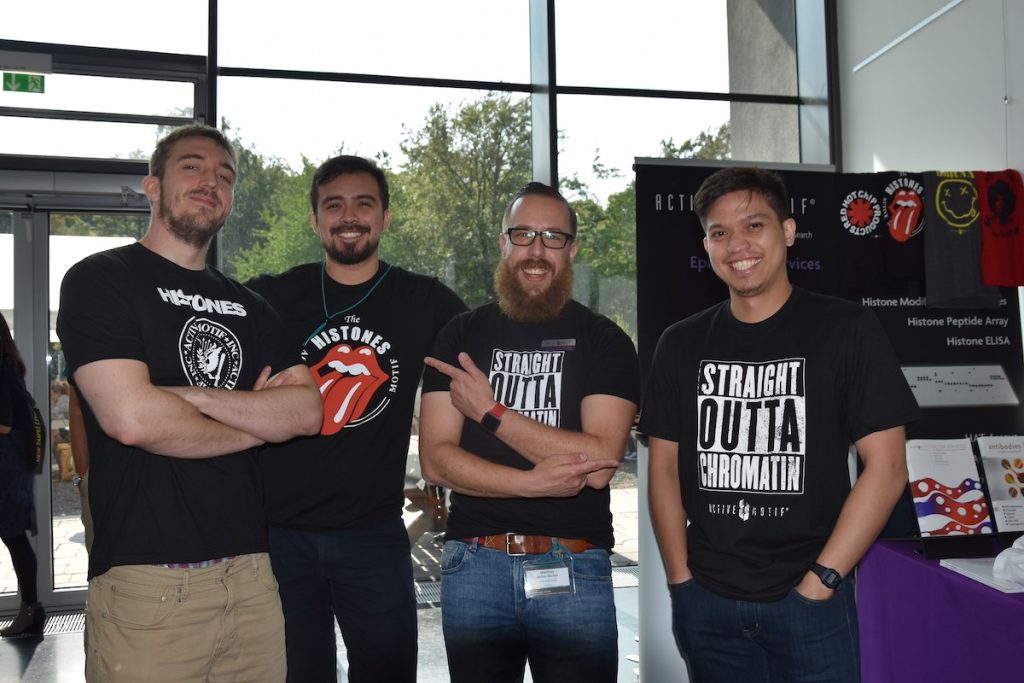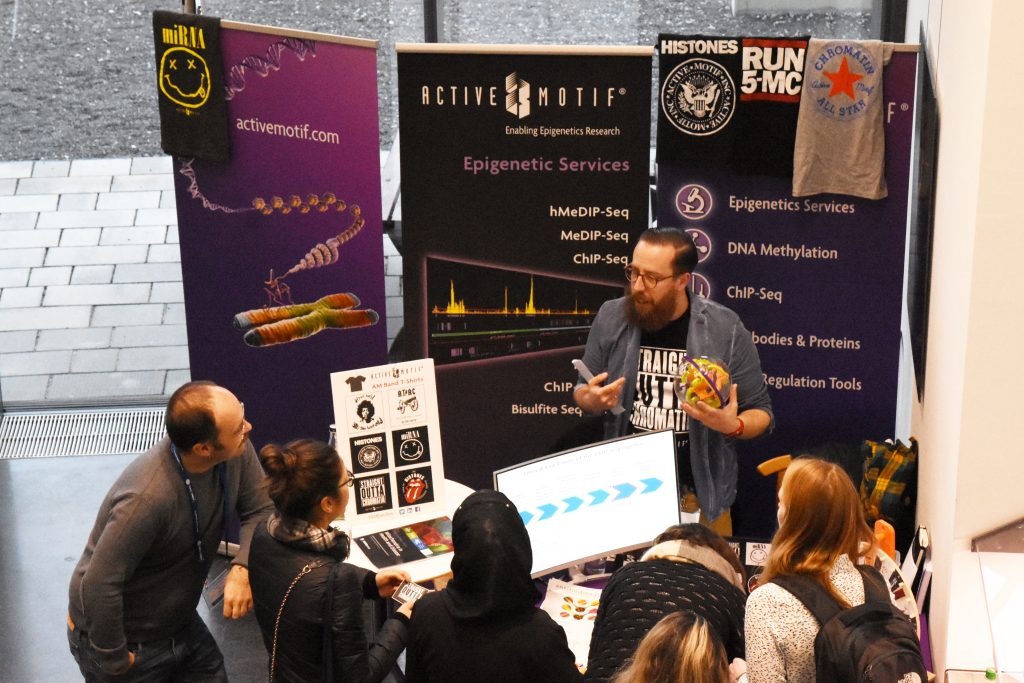How can conference exhibitors and sponsors help your research?

Meet Matthias Spiller-Becker, Key Account Manager at Active Motif Europe. Matthias acquired his PhD degree in Biology at the Centre for Molecular Biology Heidelberg (ZMBH) where he focused on chromatin and the regulation of the centromere in Drosophila. Now in his 7th year at the company, Matthias is one of the most familiar faces at our conferences on transcription, chromatin and epigenetics – always friendly and welcoming. The popularity of the Active Motif booth at these events has not gone unnoticed, so we asked him what the secret to this success is and what tips he can give to conference attendees when approaching exhibitors.
How many events does your company exhibit at annually?
In general we participate in about 50+ conferences and meetings/workshops each year, globally. But it’s not only the big and medium-sized conferences that are important to us. We often try to be present at more intimate, local events. Sometimes we sponsor chromatin clubs where only a couple of students and postdocs come together to share their latest research. And we also do a lot of tech talks where we discuss cutting-edge techniques to study gene regulation.
In the era of digital advertising, why do you still choose to be physically present at conferences?
Talking to people face to face changes EVERYTHING!
I think that’s a statement of holistic truth in life! You don’t trust companies in the first place – you trust people. You don’t buy your antibodies or reagents from companies. You buy from people!
And even more: you don’t give away your scientific baby (aka outsourcing your project) to strangers – you give it to people you know and trust. Sure, it happens a lot that folks in the lab search an assay on the web and inform themselves about alternatives on the market before making their “informed” decision, but that is often not the end of the story. It turns out that students and postdocs mostly need to get in touch with us at some point during the experimental process to further discuss their project. And surprisingly often, this first interaction happens at conferences as in “hey, are you working for Active Motif…I think we used your antibody. Can I ask you something?…”. Moreover, being physically present at the conferences is the only way to stay current with cutting-edge research. We discuss with people at their posters and also join the conference sessions in order to see the latest and future trends in chromatin and gene regulation research.
Apart from presenting their newest technology and developments, what else can exhibitors offer participants?
Networking, distraction, fun, and a “Staun-Anlass” (hard to translate that word but probably a reason to positively wonder nails it). Basically, you want to be the red bean in a jar full of green beans. You want to be distinct and recognised among others, leaving a positive impression that lasts.
During my PhD, I always liked companies that didn’t come around too stiff at conferences, but were more “approachable”. As a student it takes courage to cross the invisible boarder at a company booth – you don’t want to end up in the web of the sales spider. You are afraid that the company representative might talk you into buying something you never really wanted.
I know this feeling personally – so I try to avoid that when talking to people. My daily goal (whether at a conference or elsewhere) is to be able to help people a bit further. Having a chat at the conference booth can do many things. For example, you may learn that the problem you are discussing with the exhibiting company is indeed a bigger one that’s not to be solved easily. That’s great information! You may also hear that your problem is actually easy to address and solve – even better! You may get info about peers in the same boat as you => networking!
And last but not least, you may simply want to use the chance of talking to people in industry to get an idea about their journey in life & science => career chat!
I try to offer all the above to the people that get in touch with me during a conference!

What tips can you give participants on how to approach exhibitors?
DON’T BE SHY! Just go and talk to them.
Of course, you need to choose your battles. Often it helps to orient yourself first. Do you already know the company? Is there an overlap between your research and them? If not, just read their banners and roll-ups. Sounds trivial but many people don’t do that. A company would hopefully try to have the most prominent and distinct features of their capabilities written or otherwise sketched out on their banners. If you don’t find any overlap there, I would not necessarily approach them.
But beware: company roll-ups can be like lab websites. Some truths are stated, and some are hidden, so even if your fancy new technique is not mentioned there, as long as the company topic seems to fit your science, go check them out.
If you just want a pen or some chocolate but otherwise, they don’t interest you – simply tell them upfront. You will still get your sweets but honestly, how many pens does a single person need?! 🙂
Can you give an example of a mutually beneficial collaboration that has arisen at your booth through your presence at a conference as an exhibitor?
There are so many examples. It frequently happens that conference participants approach me and tell me that they have an issue with a given technique, mostly Chromatin IP. It turns out that talking them through the experiment step by step often yields at least one weak spot in the setup.
A classic is that people often use the same amount of antibody for ChIP, independent of the varying targets and the respective antibody clones they may use. This is (like many protocol-related “facts” in the life sciences) a dogmatic – or nearly a religious – topic. People can be determined to use “always 2 µg of antibody”. Then you ask them “but did it work when using 2 µg?” and they may need to admit that “no, it didn’t”.
This is a good example that talking with a person outside your own lab can help you to critically re-consider an established protocol, and see things from a new angle.
Another example is that some projects can truly benefit from outsourcing parts of it. Everybody does it in academia but they mostly call it a “collaboration”.
You can take it a step further and outsource parts of your work to a company that offers paid scientific services. This “commercial relationship” can truly boost creativity and assay development. A company that does ChIP-Seq as a paid research service for years will always see more model organisms, more common and uncommon obstacles and more antibody targets than any other lab working only on their own project.
What approach do you use to get into contact with participants?
“It’s just me, myself and I” LOL…
No, it’s not 100 % like that but mostly…you need to simply engage the people!
I try to see every interaction with a person as the most important one in my life at that specific moment. I tend to call that my “Dalai Lama approach”.
How else can you do it!? At Active Motif, we often use our chromatin-related T-shirts to break the invisible barrier between conference audience and the booth. People usually like nerdy science shirts and ours are no exception to that rule. I mostly play a game where people can win the shirts or at least have some distraction from the packed conference program. Often, I implement a little quiz session: people need to give me one or two lines about their research and I create a question around it. If they can answer it, they can play the game to win a shirt. This shows them that we belong to the chromatin community and they often feel more encouraged to talk about a given experiment or planned project.
Is there anything you always wanted to try out at a conference but didn’t do yet?
YES! In a perfect world, I would want to sit in a tweed jacket in my very British armchair, a boiling tea kettle next to me…people can sit down in my little chromatin tea room called “The Nucleosome” and have a relaxed chat around gene regulation and epigenetics with me, or do some networking with others.